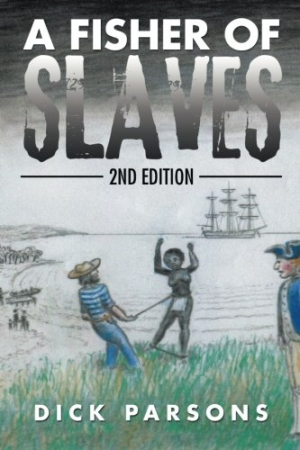A Fisher of Slaves
With its intelligent prose, A Fisher of Slaves will not disappoint historical fiction fans who gravitate to Hornblower-style storytelling with a touch of Georgian-era romance.
In his deftly researched and well-imagined A Fisher of Slaves, Dick Parsons sets sail on a tale that combines elements of Treasure Island with muckraking and includes a chaste but passionate romance.
In the early 1770s, thirteen-year-old Nathaniel has finally persuaded his mother, Elizabeth, to allow him to sign up as an apprentice mate on a ship. Elizabeth seeks out James Youle, captain of the Dolphin, whose stellar reputation is reassuring. However, she learns too late that the pragmatic Youle has taken captaincy of the Mary Anne, a slave ship. Elizabeth, a passionate abolitionist, has committed her son to the slave trade.
This engrossing tale splits into two plot threads as the Mary Anne and Youle embark for Africa. Nathaniel learns about canvas, ropes, navigation, and standing watch, helped by a kindly chief mate. Youle becomes a father figure, treating Nathaniel well. At home in England, Elizabeth remains unaware that Youle has fallen in love with her and is questioning everything.
Parsons’s second plotline follows Elizabeth, sturdy in her belief that “[s]lavery is an outrage, a grotesque atrocity, an affront to human dignity,” as she attempts to join abolitionist causes. Educating herself, she befriends Reverend David Hart, curate in a nearby village, whose Caribbean relatives are slave owners. Affection develops on both sides. The text is wonderfully perceptive and analytical when it comes to this pair and their social milieu.
The novel captures the horrors of the slave trade ably in several scenes, allowing Nathaniel to understand the ugly business transpiring. Parsons also makes note of African participation in the slave trade, which is a potentially surprising historical detail. On the journey to the Caribbean, Parsons uses the tortured details of caging, controlling food and water to control the captives, allowing them into fresh air sparingly, and burying “flux” (dysentery or typhoid) victims at sea to move Youle toward being a more sympathetic character.
Perhaps because the author is a veteran of almost four decades of naval service, the book’s nicely paced plot and interesting and believable characters work in front of clear knowledge of ships, sailing, and the sea. Still, the book may be faulted for its abrupt changes in point of view and sudden transitions, though these do not greatly affect reading pleasure.
With its interestingly designed primitive folk art cover and intelligent prose, A Fisher of Slaves will not disappoint historical fiction fans who gravitate to Hornblower-style storytelling with a touch of Georgian-era romance.
Reviewed by
Gary Presley
Disclosure: This article is not an endorsement, but a review. The publisher of this book provided free copies of the book and paid a small fee to have their book reviewed by a professional reviewer. Foreword Reviews and Clarion Reviews make no guarantee that the publisher will receive a positive review. Foreword Magazine, Inc. is disclosing this in accordance with the Federal Trade Commission’s 16 CFR, Part 255.

